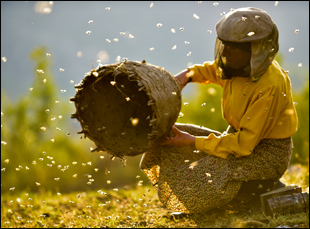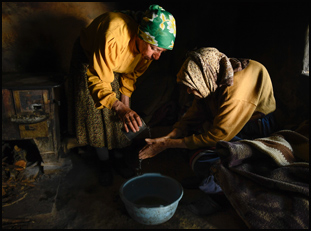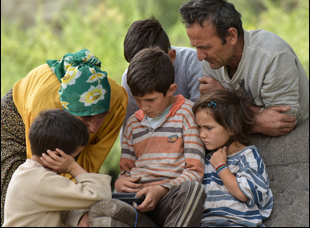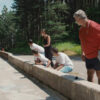Less than a week into filming what would become “Honeyland,” Ljubomir Stefanov and Tamara Kotevska accompanied Hatidze Muratova, a beekeeper in a remote part of Macedonia, to collect honey from one of the hives she has in the area when they knew they were onto something special. Kotevska had already suspected she was a compelling character when Stefanov had brought back pictures of Hatidze after a scouting expedition to the region with the intention of making a film about bees’ crucial ecological role, her commune with the insects running so deep she needed not to wear a mask around them. But those instincts were borne out upon seeing Hatidze speak softly to the bees as she delicately scraped the honeycomb into jars she could sell at a nearby market, telling them, “Half for me, half for you.”
“It was clear that motto is crucial for the story,” says Stefanov, who with Kotevska would spend the next three years visiting Hatidze to uncover a profound tale about environmental sustainability as well as profile a truly remarkable woman.
Tending to her 85-year-old mother Nazife, who is confined to the small cabin the two share after losing her sight and much of her sense of hearing, Hatidze can be seen in “Honeyland” as the last of a generation of wild beekeepers in Europe who is careful not to take too much away from the bees that she relies on income. She doesn’t require much, living far from civilization with no electricity and a well for water, but it’s undoubtedly not the easiest life and it only gets harder when she’s joined on the land by a family that takes an interest in cultivating a bee business of their own, though likely at a larger volume than Hatidze to feed a family of seven, jeopardizing the harmonious balance of human needs and nature’s that Hatidze has worked so hard to attain.
In telling her story in such bracingly intimate fashion, filmed only with the light that was available from the sun and the moon, Stefanov and Kotevska bring out natural beauty that isn’t confined to Macedonia’s breathtaking landscapes as Hatidze is delighted to share her wisdom with her neighbors and their young children, at least at first, and shows selflessness and sensitivity that you wish she could bottle up and distribute along with her honey when she goes into the city. Yet “Honeyland” proves to also be exceptionally provocative in being able to illustrate simply and effectively how precarious our relationship to the environment is and the responsibility we have to be conscientious stewards. Becoming a sensation when it premiered earlier this year at the Sundance Film Festival where it won the Grand Jury Prize in the World Cinema Documentary section, the film arrives in theaters this week and while in Los Angeles, Stefanov and Kotevska spoke of how they took great care in bringing the story to the screen, somehow avoided getting stung and doing their part for the subjects’ sustainability.

Ljubomir Stefanov: Actually, this is our second movie we’ve done together and while finishing the first one, we started doing research for certain nature project in our country. During that research, our task was to explore the area and to find a subject for a short documentary, but when we found Hatidze, we realized it wouldn’t be short.
Is it true there was a completely different story in mind at the start of filming?
Tamara Kotevska: The difference between me and [Ljubo] is that he comes from an environmental background, working mostly with short documentaries focused on plants and animals. He didn’t work before with humans and dramaturgical structure of a long [piece] and I come from a film school in Macedonia where I graduated in documentaries, but my main focus was in social themes and people, so combining the two was the best thing we could [do] because everything was covered. So in these three years, we tried to make this film equally about the environment and about humans, and we saw there was actually no difference because Hatidze’s story pretty much resembles the story of a bee. If you see all the structure of the film, there’s the strong symbolism of bee society – you have the worker bee, who’s the main character Hatidze. You have her mother, the Queen bee who never abandons the home and then you have the other group of bees on the same territory that starts attacking each other, so in this time, you actually see there’s not a difference between our world and all the other smaller worlds around us, something that we usually forget.
Were the neighbors there at the start or did they move in during filming?
Tamara Kotevska: The neighbors actually are nomads, so they come and go every season. When we came in at the beginning, they were not there and came [when] we started shooting, but at first we didn’t pay attention to them because we were focused on Hatidze and then we started working with them because we realized that in this story about her, we needed to show the biggest conflict that she has with her environment. We realized her story could not go without these people and without the conflict they have because it’s the crucial conflict that all humanity has in a way.
Also in terms of interaction with the characters, with Hatidze, it was not a problem at all because she wanted to tell her story. She collaborated with us, and the mother was completely blind and deaf and Hatidze was the only person who could interact with her. With the other family, it was the biggest problem of how to get in touch, how to gain their trust and how to come to a point when they behave just normally from the camera.
Ljubomir Stefanov: And they accept you and open themselves up to you.

Ljubomir Stefanov: That’s why we had two directors and two cinematographers splitting [up the filming of the separate families].
Tamara Kotevska: It’s on purpose we were two by two basically because this is the best way we saw things working – not always, but we were very often splitting in teams because very often we had limited time to stay there. For example, one weekend we were there, we would split — one director, one cinematographer would work with one family — and then we would switch, so it worked.
The form of Turkish Hatidze speaks is said to be ancient. Could you understand what was unfolding in front of the camera in body language only?
Ljubomir Stefanov: We didn’t understand it at all, so we focused on visual mainly.
Tamara Kotevska: Body language is the crucial thing that made this film look like it does.
Ljubomir Stefanov: The first version of editing, we were editing on mute basically and during that time we had four translators translating the dialogue. After the first version, we put the transcript [up with the footage] and it was a big surprise because we were watching somehow the same film, but with dialogue we couldn’t even imagine in our film.

Tamara Kotevska: Large limitations. First of all, it’s impossible to get there by a regular car, it made a huge problem with the transport because every time we had to rent a special vehicle.
Ljubomir Stefanov: It’s an all-terrain vehicle, but it was small and we were a crew of four, plus supplies, plus equipment.
Tamara Kotevska: So this limited the number of people that can go there. We had the same team that worked on the previous film, but we couldn’t have a sound recorder…
Ljubomir Stefanov: We have a brilliant sound designer from Beirut, Rana Eid, and she squeezed the material to the maximum to extract all the sounds she can use [from our DSLR cameras] to produce what you see now.
Tamara Kotevska: And once we started going there, we realized once the subject in a documentary gets used to you, it’s not that easy to change a member from the team because they accept you like a member of the family. Any time we thought about bringing an extra person or maybe some cameraperson, if we invited them, it didn’t work, so we had to stick with just the four of us. And then the obstacle was how to bring supplies there because there’s nothing you can keep the supplies in. We were sleeping in tents and cats were eating our food all the time because there’s not a place to put it, so this was maybe the biggest adventure for us.
Was filming around bees actually an issue?
Tamara Kotevska: Well, not when Hatidze is there obviously because she knew how to behave with them. She basically taught us how to not act nervous around the bees and we never got stung. Just one of the DOPs when he was working with the other family because they’re more aggressive with their bees.
Ljubomir Stefanov: But in 100 filming days, only once, one person once. And we didn’t take any protection.

Tamara Kotevska: Unreal, because at first we were trying to do the best out of the story step by step we saw slowly how people were reacting in these three years. We were making focus groups with other filmmakers from Macedonia, colleagues of ours, friends and family. But this is all very local, so you can’t know. Once we went to Sarajevo [Film Festival with a work-in-progress], it was the first actual proof of what we have and what direction we need to take this in the future. From that moment on, things just started growing, and eventually Sundance was the biggest proof of our work and the meaning of this subject globally. We’re very happy to see how completely different societies react.
What was interesting is that every country we’ve been, depending on the social problem that is the strongest in their country, they could connect to a different layer in the story. This was very meaningful to see how many layers there are. For example, when we went to Hong Kong, people were mostly connected to Hatidze’s solitude and her relationship to her mother. They could see this in their society as a problem – this loneliness and this disconnection to each other. Then it was interesting when we came to New York for the first time for the screening, somebody from the audience on the question of the other family’s [relationship] to Hatidze and [how] they didn’t care how they took [away] from her [property] and somebody said, “This is just like us,” meaning all of us because consumerism is something in the Western society that becomes a huge problem.
Ljubomir Stefanov: And we used the first award from Sarajevo, an award for a work-in-progress section, to buy a new house for Hatidze in a nearby village, populated by relatives and friends and then we started a campaign [with rewards of] jars of honey and with that fund, we’ll try to help [her] and the other family in their needs. The family always needs something for the kids — they have seven children in the film and actually on the day of the premiere, they give birth to their eighth, so now they’re 10 people and they really need help and we try to help.
“Honeyland” opens on July 26th in Los Angeles at the Royal Theater and New York at the Quad Cinema. A full schedule of screenings and dates is here.




